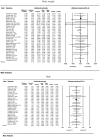The Effects of Concurrent Training Versus Aerobic or Resistance Training Alone on Body Composition in Middle-Aged and Older Adults: A Systematic Review and Meta-Analysis
- PMID: 40218073
- PMCID: PMC11989159
- DOI: 10.3390/healthcare13070776
The Effects of Concurrent Training Versus Aerobic or Resistance Training Alone on Body Composition in Middle-Aged and Older Adults: A Systematic Review and Meta-Analysis
Abstract
Introduction and Aim: The beneficial effects of aerobic training (AT) on preventing excess fat mass, and of resistance training (RT) on skeletal muscle adaptation, are well established. However, the effects of concurrent training (CT) compared to AT or RT alone on body composition in middle-aged and older adults are less understood, and therefore, the focus of this meta-analysis. Methods: Three databases, including PubMed, Web of Science, and Scopus, were searched from inception to March 2024. Randomized trials were included if they compared CT versus either AT or RT, and included body composition measures such as fat mass, body fat percentage, waist circumference, visceral fat mass, lean body mass (LBM), muscle mass/volume, or muscle or muscle fiber cross-sectional area (CSA), in middle-aged (50 to <65 years) and older adults (≥65 years). Weighted mean differences (WMD) or standardized mean differences (SMD) and 95% confidence intervals (CIs) were calculated using random effects models. Results: A total of 53 studies involving 2873 participants were included. Overall, CT increased body weight and LBM significantly more, trending toward significantly larger increases in muscle mass and CSA, compared with AT alone. However, there were no significant differences between CT and RT alone, for body weight, BMI, body fat percentage, fat mass, waist circumference, or visceral fat mass. Conclusions: CT is as effective as AT for decreasing body fat measures and as effective as RT for increasing muscle mass in middle-aged and older adults, and it should be recommended accordingly.
Keywords: body composition; concurrent training; fat mass; muscle mass; older adults.
Conflict of interest statement
The authors declare no conflicts of interest.
Figures









Similar articles
-
Comparison of concurrent, resistance, or aerobic training on body fat loss: a systematic review and meta-analysis.J Int Soc Sports Nutr. 2025 Dec;22(1):2507949. doi: 10.1080/15502783.2025.2507949. Epub 2025 May 22. J Int Soc Sports Nutr. 2025. PMID: 40405489 Free PMC article.
-
The effects of exercise training on body composition in postmenopausal women: a systematic review and meta-analysis.Front Endocrinol (Lausanne). 2023 Jun 14;14:1183765. doi: 10.3389/fendo.2023.1183765. eCollection 2023. Front Endocrinol (Lausanne). 2023. PMID: 37388207 Free PMC article.
-
Effects of Concurrent Strength and Endurance Training on Measures of Physical Fitness in Healthy Middle-Aged and Older Adults: A Systematic Review with Meta-Analysis.Sports Med. 2023 Feb;53(2):437-455. doi: 10.1007/s40279-022-01764-2. Epub 2022 Oct 12. Sports Med. 2023. PMID: 36222981 Free PMC article.
-
Effectiveness of whey protein supplementation on muscle strength and physical performance of older adults: A systematic review and meta-analysis of randomized clinical trials.Clin Nutr. 2024 Oct;43(10):2412-2426. doi: 10.1016/j.clnu.2024.08.033. Epub 2024 Sep 5. Clin Nutr. 2024. PMID: 39303495
-
Effect of SGLT-2 inhibitors on body composition in patients with type 2 diabetes mellitus: A meta-analysis of randomized controlled trials.PLoS One. 2022 Dec 30;17(12):e0279889. doi: 10.1371/journal.pone.0279889. eCollection 2022. PLoS One. 2022. PMID: 36584211 Free PMC article.
Cited by
-
Effects of Resistance Training on Pain, Muscle Strength, and Function in Patients Undergoing Total Knee Arthroplasty: A Systematic Review and Meta-Analysis.J Clin Med. 2025 Jul 14;14(14):4979. doi: 10.3390/jcm14144979. J Clin Med. 2025. PMID: 40725673 Free PMC article. Review.
-
Comparative effectiveness of high-intensity interval training and moderate-intensity continuous training on cardiometabolic health in patients with diabesity: a systematic review and meta-analysis of randomized controlled trials.Diabetol Metab Syndr. 2025 Aug 13;17(1):331. doi: 10.1186/s13098-025-01909-z. Diabetol Metab Syndr. 2025. PMID: 40804647 Free PMC article. Review.
-
Impact of aerobic exercise on chronic inflammation in older adults: a systematic review and meta-analysis.BMC Sports Sci Med Rehabil. 2025 Aug 8;17(1):229. doi: 10.1186/s13102-025-01279-z. BMC Sports Sci Med Rehabil. 2025. PMID: 40781686 Free PMC article.
References
-
- Kuk J.L., Saunders T.J., Davidson L.E., Ross R. Age-related changes in total and regional fat distribution. Ageing Res. Rev. 2009;8:339–348. - PubMed
-
- Wannamethee S.G., Shaper A.G., Whincup P.H. Body fat distribution, body composition, and respiratory function in elderly men. Am. J. Clin. Nutr. 2005;82:996–1003. - PubMed
-
- Janssen I., Ross R. Linking age-related changes in skeletal muscle mass and composition with metabolism and disease. J. Nutr. Health Aging. 2005;9:408. - PubMed
Publication types
LinkOut - more resources
Full Text Sources

